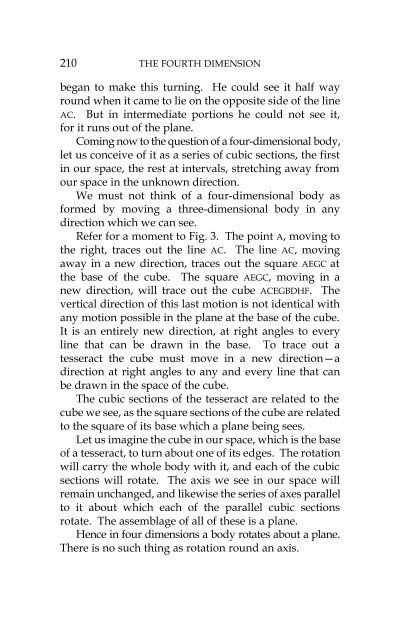You also want an ePaper? Increase the reach of your titles
YUMPU automatically turns print PDFs into web optimized ePapers that Google loves.
210<br />
THE FOURTH DIMENSION<br />
began to make this turning. He could see it half way<br />
round when it came to lie on the opposite side of the line<br />
AC. But in intermediate portions he could not see it,<br />
for it runs out of the plane.<br />
Coming now to the question of a four-dimensional body,<br />
let us conceive of it as a series of cubic sections, the first<br />
in our space, the rest at intervals, stretching away from<br />
our space in the unknown direction.<br />
We must not think of a four-dimensional body as<br />
formed by moving a three-dimensional body in any<br />
direction which we can see.<br />
Refer for a moment to Fig. 3. <strong>The</strong> point A, moving to<br />
the right, traces out the line AC. <strong>The</strong> line AC, moving<br />
away in a new direction, traces out the square AEGC at<br />
the base of the cube. <strong>The</strong> square AEGC, moving in a<br />
new direction, will trace out the cube ACEGBDHF. <strong>The</strong><br />
vertical direction of this last motion is not identical with<br />
any motion possible in the plane at the base of the cube.<br />
It is an entirely new direction, at right angles to every<br />
line that can be drawn in the base. To trace out a<br />
tesseract the cube must move in a new direction—a<br />
direction at right angles to any and every line that can<br />
be drawn in the space of the cube.<br />
<strong>The</strong> cubic sections of the tesseract are related to the<br />
cube we see, as the square sections of the cube are related<br />
to the square of its base which a plane being sees.<br />
Let us imagine the cube in our space, which is the base<br />
of a tesseract, to turn about one of its edges. <strong>The</strong> rotation<br />
will carry the whole body with it, and each of the cubic<br />
sections will rotate. <strong>The</strong> axis we see in our space will<br />
remain unchanged, and likewise the series of axes parallel<br />
to it about which each of the parallel cubic sections<br />
rotate. <strong>The</strong> assemblage of all of these is a plane.<br />
Hence in four dimensions a body rotates about a plane.<br />
<strong>The</strong>re is no such thing as rotation round an axis.






![[PDF] Prolegomena](https://img.yumpu.com/16774951/1/190x245/pdf-prolegomena.jpg?quality=85)









